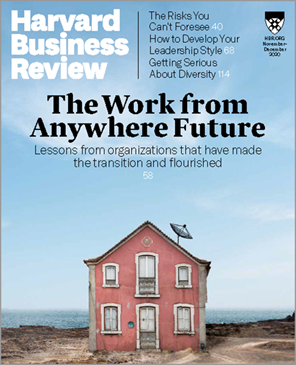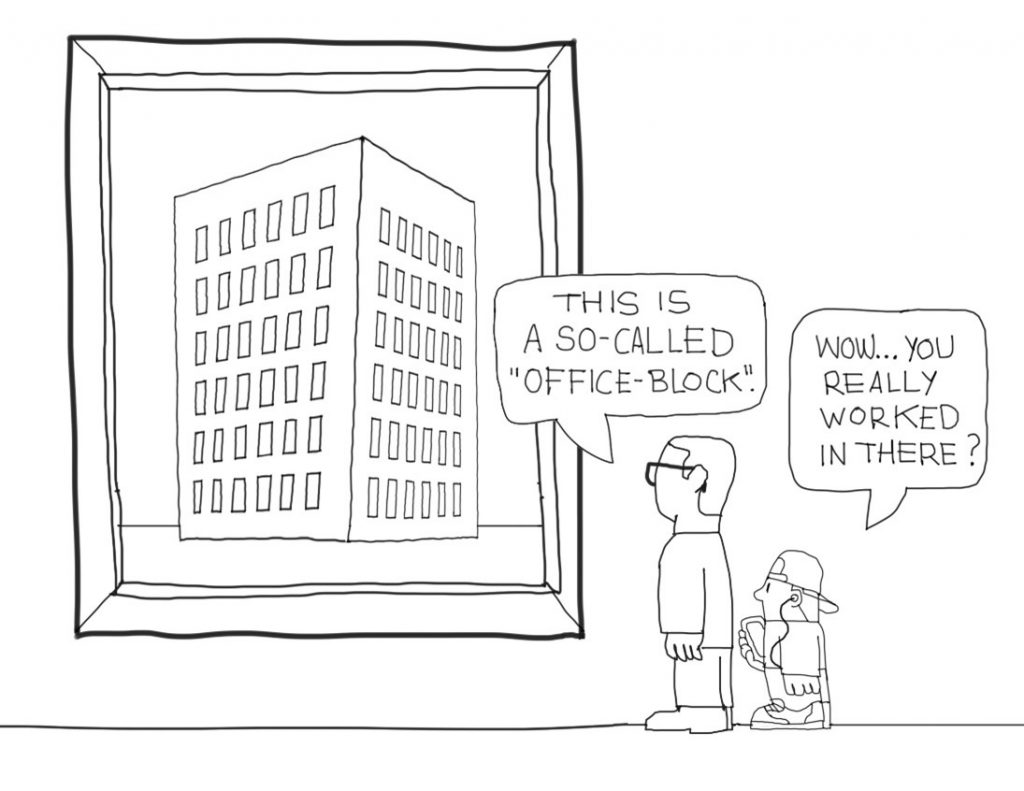The cover article of the November/December issue of Harvard Business Review features a comprehensive article (by Prithwiraj Choudhury) on remote working, and it inspired me to take a look at the remarkable shift that has taken place during 2020. Choudhury has spent 5 years studying practices of WFA organizations. Literal quotes from his article are shown in italic.
Before the Covid crisis, working from home was seen as a privilege. The best employees, most trusted by the manager, could get permission to work from home on let’s say every other Friday to have the luxury of missing the daily commute and taking the time to pick up the children from school.
During 2020, this situation has flipped completely. The ‘indispensable’ employee may be allowed to book a desk in the office for a day, in order to attend a high impact meeting or meet F2F with other key players to attend to important business. I find it highly intriguing that our view on the way we organize collaboration has changed so radically in such a short timeframe.
Choudury’s says: ‘We learned that a great many of us don’t in fact need to be collocated with colleagues on site to do our jobs. Individuals, teams, entire workforces can perform well while being entirely distributed.’

For those of us who work in geographically dispersed (global) teams, we already knew, long before Covid, that remote team members can be trusted to be just as highly committed to their task and team as team members in the same place. Even when the manager is asleep, her team members in a different time zone will likely be self-drive to deliver high performance.
So, if Working from Anywhere (WFA) is the new normal, what are its benefits, challenges and how do we overcome the challenges?
Benefits
Benefits for the organization
- Reducing or eliminating real estate cost
- Hire talent globally, without the obstacles of immigration policies
- Staff each project with the best suited team members, regardless of location: ‘talent in the cloud’ (Gopinathan, 2020)
- Productivity gains: different studies report gains between 4.4 and 22%. It is likely that employees working from home set higher standards for themselves (Bloom, 2013) and, commuting time is (partially) used to do more work
- Increased employee engagement
- Increased employee retention
- Remote workers tend to take fewer sick days. This may be due to the fact that it is easier to continue working at home when feeling a bit ‘out of the weather’. In the case of having a long commute, the employee might have chosen to call in sick. And long commutes probably do not contribute to health in general
- More sharing of ideas in early stages through asynchronous forms of communication such as ideas, plans and documents available for all in Cloud applications.
Benefits for individuals
- Geographic flexibility for workers: people can choose to live closer to family, in nature, and in place with lower housing cost. Apparently, since Covid, there is a trend for people to leave urban areas and move to the countryside for these reasons. ‘Warmer weather, prettier views and greater recreational opportunities.’
Dual career couples can manage their lives more easily. If one partner needs to relocate for work and the spouse can WFA, then the dilemma is solved.

- A better work -private life balance: the ability to integrate private commitments into the workday. There are obvious downsides to this too, which we’ll look at in the next paragraph.
- More opportunities for women whose careers were previously limited by cultural norms against travelling
Challenges and how to overcome them
Building & maintaining remote relationships
Remote workers report feelings of isolation, both professionally and personally. Many find it harder to build friendships with colleagues.
What can be done
- Managers take on an increased responsibility for their direct reports mental and physical well-being
- Actively practice inclusion and watch out for subgroups (‘us and them’) based on geographical dispersion or between ‘those in the office and those remote’
- Social elements: introduce virtual watercoolers (planned social interactions)
- Encourage online chatting
- Virtual Café pre-meetings
- Temporary colocation events: inviting all workers to spend a few days with colleagues in person
- Remote communities of practice: socialize, discuss work and problem solve in a nice location with peers who live in the same geographical area

Communication around complex tasks...
… such as problem solving, creating products or services or conflict resolution works very differently in a remote context. Due to time zone differences, there is less ‘business hour overlap’ that allows for synchronous communication. Communication becomes less spontaneous.
What can be done
- More intentionally balancing the focus on task and relationship
- Building a team etiquette on how information is shared, documents are produced, updated and shared
Knowledge sharing
Much information in organisations is not codified and resides in people’s heads, which also tends to happen in a face to face setting.
What can be done
- Creating transparent and easily accessible documentation
- Codifying knowledge and freely sharing information
- Creating a repository of materials that people can view at their convenience, such as transcripts, public slides, recordings of meetings and conferences.
Performance evaluation and compensation
Performance management in a collocated setting is often based on input: how much time does an employee spend at work. In a remote setting, it shifts to measuring output and is centred around trust.
What can be done
- Defining performance indicators based on output, such as: quality, timeliness, quality of virtual interactions, feedback from peers and customers.
- Micromanagers may be attracted to use software exists that track worker productivity. This type of tool measures input and does not fit with a trust-based model of remote performance management.
Data security and regulation
A threat to security can be the use of personal, less protected devices by employees at home, such as open Wi-Fi networks. Also, employees could -intentionally or unintentionally- use confidential company data to share with others.
What can be done
Organisations are conducting large scale experiments with a wide range of solutions to protect client data using predictive analytics, data visualization and computer vision.
Conclusion
In the opinion of Neal Gandhi’s, CEO of Quicksmart Global in the UK, being remote has a magnifying effect on leadership skills. Bad managers fail miserably, and good managers become excellent in a remote context. How can they be successful? Choudhury summarizes it like this:
‘If leaders support synchronous and asynchronous communication, brainstorming and problem solving; lead initiatives to codify knowledge online, encourage virtual socialization, team building and coaching; invest in data security, work with governments to ensure regulatory compliance; and set an example by becoming WFA employees themselves, all remote organisations may indeed emerge as the future of work.’

Fredrik Fogelberg is a chartered Organisational Psychologist specializing in leadership development and team facilitation in international organizations. He has over 30 years of international experience in the corporate world and as a consultant.



